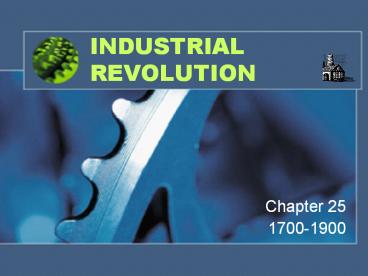INDUSTRIAL REVOLUTION - PowerPoint PPT Presentation
1 / 18
Title:
INDUSTRIAL REVOLUTION
Description:
Title: INDUSTRIAL REVOLUTION Author: Michelle Morris Last modified by: mmorris50 Created Date: 1/17/2006 4:41:44 AM Document presentation format: On-screen Show – PowerPoint PPT presentation
Number of Views:83
Avg rating:3.0/5.0
Title: INDUSTRIAL REVOLUTION
1
INDUSTRIAL REVOLUTION
- Chapter 25
- 1700-1900
2
The Beginning
- Enclosures
- Seed Drill (1701) Jethro Tull
- Crop Rotation
- Animals (Robert Bakewell) bred his best sheep
- Population increasesdemand for workers
3
British Advantages
- 1) Large Population
- 2) Natural Resources
- 3) Economic prosperity
- 4) Factors of production
- a) land
- b) labor
- c) capital
4
Textile Industry
- Flying shuttle (1733), John Kay
- Spinning Jenny (1764), James Hargreaves
- Water frame (1769), Richard Arkwright
- Spinning mule (1779), Samuel Crompton
- Power loom (1787), Edmund Cartwright
- Cotton gin (1793), Eli Whitney
- American cotton increased from 1.5 million pounds
in 1790 to 85 million pounds in 1810
5
Transportation
- 1) Steam Engine (1765), James Watt Robert
Fulton (Clermont) - 2) Roads (1800s), stones for drainage
- 3) Turnpikes to pay a toll
- 4) Railroad (1820s)
- RR advantages
- Cheap
- New Jobs
- Transport industries to distant areas
- Travel for distant jobs
6
Urbanization
- Urbanizationcity building and movement of people
to cities - London became Europes largest city of 1 million
- Living conditions
- Garbage
- Shelters
- Cholera epidemics
- Lifespan
7
Urbanization cont.
- Working conditions
- 14 hours a day
- 6 days a week
- New dangers
- Injuries, no aid
- Coal mines and breathing
- Child labor
- Pollution
8
Urbanization cont.
- Class tensions
- Middle class is a social class of skilled
workers, professionals, businesspeople, and
wealthy farmers - Upper middle classgovt workers, doctors,
lawyers, and managers of factories - Lower middle classtoolmakers, drafters,
printers, and factory overseers - Education
- Demand for clerical workers needing education
9
Industrialization Spreads
- United States
- Samuel Slater emigrated and build spinning
machine from memory - Moses Brown opened 1st factory in Rhode Island in
1790
10
Later Expansion
- 1) Natural resources of oil, coal, and iron
- 2) Inventions of electric light bulb and
telephone - 3) Urban population boom
- 4) RR
- 5) Corporationsbusiness owned by stockholders
who share in its profits but not responsible for
debts - Standard OilJohn D. Rockefeller
- Carnegie Steel CompanyAndrew Carnegie
11
European Industrialization
- French Revolution and Napoleonic Wars
- Belgium technology leader
- Germany imports and sends children to learn
- German RR
- Social structure and geography delay other areas
12
Reforms
- Laissez-faire
- Letting owners of industry and business set
working conditions without interference, favors
free-market, from France - Adam Smith (1776) Wealth of Nations
- Opposed govt efforts to help workers such as
minimum wages and better working conditions
13
Reforms
- Capitalism
- An economic system in which money is invested in
business ventures with goal of making a profit - Thomas Malthus
- Argued that population increased more than food
supply without wars and epidemics so most were
destined to be poor and miserable - David Ricardo
- Permanent underclass would always be poor
14
Socialism
- Utilitarianism
- Bentham thought people should judge ideas,
institutions, and actions on the basis of their
utility or usefulness - Also push for reforms in legal, educational and
prison systems - Utopia
- Robert Owen built society in Indiana
15
Socialism
- Socialism
- Factors of production are owned by the public and
operate for the welfare of all - Govt should plan the economy
- Karl Marx and Friedrich Engels wrote The
Communist Manifesto - Havesemployersbourgeoisie
- Have-notsworkersproletariat
- Final phase of communism would be complete
socialism in which production would be totally
owned by people and private property would cease
to exist - Religion, nationalism, ethnic loyalties, and
democracy have influenced society so that
socialism has not succeeded
16
Unionization
- Collective bargaining
- Negotiations between workers and employers
- Strike or refuse to work if conditions are not
acceptable - Led to American Federation of Labor (AFL)
- Reform laws
- Factory Act of 1833no worker under 9, 9-12 only
8 hours, 13-17 only 12 hours - Mines Act of 1842no women/children underground
- Ten Hours Act of 184710 hour workday for W/C in
factories
17
Other Reformers
- William Wilberforce
- Worked to abolish slavery in Britain (1833)
- Jane Addams
- Worked for womens rights in mid-1800s
- Horace Mann
- Worked for free public education in US
18
(No Transcript)































